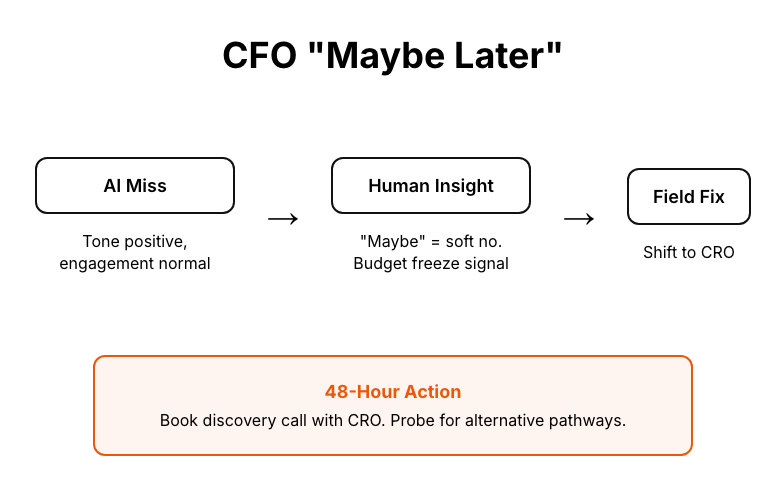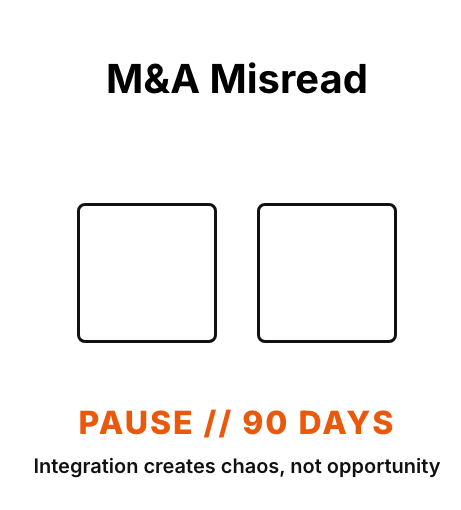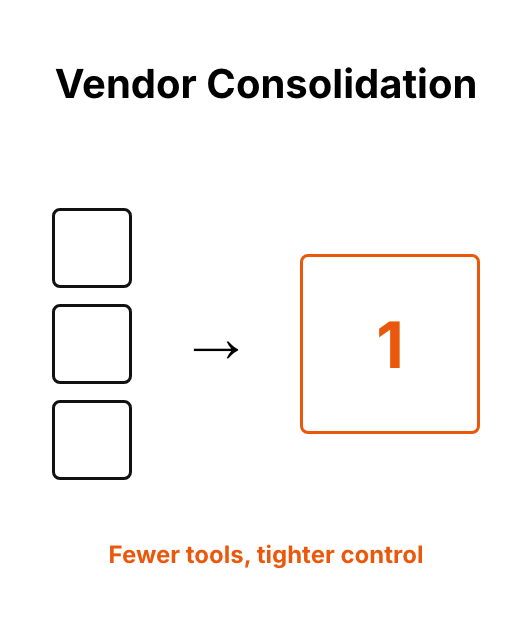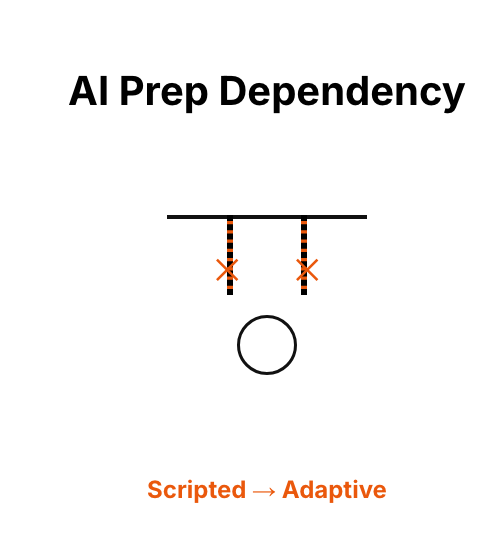Why AI can not replace top sales reps yet
Explore 20 revenue-critical scenarios where AI misreads cost deals, from CFO risk signals to political dynamics AI can’t detect.
The AI discovery race has created a new problem:
Everyone’s automating the same surface-level intelligence. Perfect personalization. Flawless tone. Beautiful execution.
Zero differentiation.
Here’s the uncomfortable truth we’re seeing across pipeline reviews: AI can detect what was said, not what was meant.
It’s mastered surface intelligence, but not empathy.
The signal-to-narrative gap is widening. Reps are trusting the transcript more than the tone.
Example:
CFO says “maybe later” on a call. AI logs it as a budget delay. Deal moves to Q3. Your rep notes indicators of political risk aversion and personal credibility concerns.
The real moat for modern sales orgs is diagnostic depth.
This article breaks down 20 real-world diagnosis gaps and shows how leading organizations are rebuilding hybrid discovery systems around human interpretation.
By the time you finish, you’ll have a repeatable framework for extracting causality from conversations.
The 5-Layer Diagnostic Stack (Your New Framework)
The future of discovery won’t be AI vs. human; it’s AI for prep, human for interpretation.
Top-performing CROs don’t just use AI to find facts; they train their reps to probe across five layers of a prospect’s reality.
Layer 1: Business Layer
What It Reveals: KPIs, revenue targets, ROI levers.
AI Capability: Partial (Can confirm priorities).
Human Role: Confirm priorities.
This is where AI performs best. It can pull annual reports, parse earnings calls, identify strategic initiatives from press releases. Your AI can tell you that the CFO cares about EBITDA margin expansion and that the company just launched a cost-reduction initiative.
What AI can’t do: Understand which of those five priorities will actually get funded this quarter based on executive tenure, board pressure, or competitive threats.
Layer 2: Technical Layer
What It Reveals: Tools, integrations, dependencies, stack gaps.
AI Capability: Partial (Can validate constraints).
Human Role: Validate constraints.
AI excels at mapping the tech stack. It knows they’re using Salesforce, Outreach, ZoomInfo, and Gong. It can even flag integration complexity.
What AI can’t do: Detect that the CTO is privately frustrated with their current SEP vendor but can’t convey it to procurement. Or that the “Salesforce migration” (mentioned casually) will freeze all other decisions.
Layer 3: Temporal Layer
What It Reveals: Timing, urgency, quarter-end constraints.
AI Capability: Partial (Can probe “why now”).
Human Role: Probe “why now”.
AI can identify calendar events: earnings calls, fiscal year-end, contract renewals. It can suggest urgency-based messaging.
What AI can’t do: Distinguish between manufactured urgency (vendor trying to hit quota) and genuine urgency (compliance audit deadline that keeps the VP up at night).
Layer 4: Political Layer
What It Reveals: Power dynamics, decision authority.
AI Capability: ❌ (Cannot read org chart subtext).
Human Role: Map influence lines.
AI can scrape LinkedIn and build an org chart. It knows who reports to whom.
What AI can’t detect: That the VP of Sales hates the CMO. That the new CRO is auditing every vendor relationship. That the “executive sponsor” you’ve been talking to for three months was just moved to a different division and your deal is now nowhere.
Layer 5: Emotional Layer
What It Reveals: Fear, pride, risk appetite, ambition.
AI Capability: ❌ (Cannot infer motive).
Human Role: Infer motive.
This is the deepest and most valuable layer.
AI sentiment analysis will tell you if the prospect sounded “positive” or “hesitant.” It might even flag “concern” based on tone modulation.
What AI can’t understand: The prospect isn’t hesitant because they don’t believe in your product. They’re hesitant because they’ve been burned before, and they’re terrified of being the executive who championed another failed tech rollout. Their career is on the line. Their hesitation isn’t about your features, it’s about their future.
Rule: AI prepares context. Humans extract causality.
The 20 Scenarios Where AI Fails (And How Top Reps Fix Them)
STRATEGIC LAYER: Where CROs Win or Lose Deals
These aren’t SDR mistakes. These are high-stakes misreads that affect forecasting, resource allocation, and board-level pipeline reviews.
Scenario 1: The CFO “Maybe Later” Signal
Your VP of Finance joins the demo. Everything goes well. At the end, she says: “This looks interesting, but maybe we should revisit this later in the year.”
AI Miss: Logged it as a budget delay. Deal moved to Q3. Pipeline value reduced.
Human Insight: Rep realized that the project was deprioritized for visibility reasons (risk aversion). Translation: “I can’t afford to champion anything non-essential right now because I’m under scrutiny.”
CRO Outcome/Fix: Reframe around cost avoidance, not cost addition. Position the solution as protecting existing budget lines, not creating new ones. This action revived the deal within 21 days on similar scenarios.
48-Hour Action: Review your current “budget objection” deals. Identify which ones are actually for risk aversion. Reframe with a “cost protection” narrative.
Scenario 2: M&A “Growth” Misread
One of your target accounts announces an acquisition. Your AI enrichment tool flags it as “Expansion opportunity - company in growth mode.”
AI Miss: Signal was a company merger, which AI said was an “Expansion opportunity”.
Human Insight: The human realized it meant integration freeze and decision fatigue (post-merger chaos). Every executive is now consumed with integration planning, culture alignment, and redundancy elimination. No chance for new vendors.
CRO Outcome/Fix: Wait 90 days. Pause outreach and re-engage during post-merger GTM reset. This leads to higher re-engagement rates.
48-Hour Action: Create a “Post-M&A Reengagement” sequence triggered 90 days after merger announcements.
Scenario 3: CRO Onboarding Window
Your target prospect just became CRO at a mid-market SaaS company. Your AI generates a congratulatory message.
AI Miss: Generated a generic “Congrats on your new role”.
Human Insight: The human realized the prospect was in a 30/60/90 reorg window and auditing outbound levers. New CROs don’t want vendor pitches. They want strategic allies who understand their 90-day priorities: diagnose current state, cut underperformers, validate stack ROI.
CRO Outcome/Fix: Map outreach to onboarding priorities. This resulted in a 2x reply lift vs. generic messaging. Your message becomes: “Congratulations on the role. Most new CROs tell us their first 90 days focus on stack audit and pipeline predictability. Would a 15-minute comparison of how similar orgs optimize outbound help?”
48-Hour Action: Build a “New CRO Playbook” sequence focused on their audit phase, not your product.
Scenario 4: Vendor Consolidation Mandate
Your champion mentions that their new CFO has a “mandate to reduce vendor count.”
AI Miss: Pushed feature comparisons. Position your tool as “best-in-class.”
Human Insight: Heard CFO language: “reduce vendor count” (CFO-driven efficiency mandate). This isn’t a “pick the best tool” conversation. It’s a “cut costs and simplify” decision.
CRO Outcome/Fix: Lead with orchestration ROI i.e. fewer tools, tighter control. Your pitch shifts from “We’re better than X” to “We replace X, Y, and Z while reducing total cost by 40%.”
48-Hour Action: Audit your current “competitive displacement” deals. Reframe around consolidation economics, not feature superiority.
Scenario 5: AI Transformation Initiative
Your prospect announces an “AI transformation initiative” in their earnings call. Your AI scores the account as “High intent.”
AI Miss: Scored as “High intent.”
Human Insight: The motivation was fear of compliance, not a drive for speed. The board pushed for an AI strategy after a competitor’s announcement worried investors.
CRO Outcome/Fix: Focus on control, not automation. Your narrative becomes: “Most AI transformation initiatives fail because of governance gaps. Our approach prioritizes auditability and compliance-first deployment.”
48-Hour Action: Segment “AI initiative” signals into two buckets: innovation-driven vs. fear-driven. Tailor messaging accordingly.
FIELD EXECUTION LAYER: Where SDRs and AEs Misread
These are the call-level misinterpretations that kill conversion rates, even when your AI says everything went well.
Scenario 6: Defensive Prospect, Hiring Freeze
Your SDR calls a VP of Sales. The prospect sounds defensive. Your AI logs the tone as “low engagement.”
AI Miss: Tagged as a flat “budget issue”.
Human Insight: Noticed tone indicating job insecurity. This VP is terrified. Their team is underperforming, headcount is frozen, and they’re one bad quarter away from being replaced.
Field Fix: Frame value as career protection, not a performance fix. Your pitch becomes: “Most VPs in this situation tell us they need quick wins that show board-level impact without requiring new headcount. Here’s how similar leaders protected their roles.”
48-Hour Action: Train reps to identify “defensive tone” as a career-risk signal, not disinterest.
Scenario 7: Technical Discovery Flatline
Your AE runs a technical discovery call. They ask about tech stack, integrations, current challenges. Prospect answers every question. Your AI summarizes the call perfectly.
AI Miss: Provided a factual summary.
Human Insight: Lacked “why now” as no urgency driver was identified. The prospect was cooperative but not compelled. No one asked: “What happens if you don’t solve this in the next 90 days?”
Field Fix: Ask about the impact of audit failure; create urgency. Add one question to every discovery call: “What’s the consequence of not addressing this before [specific deadline]?”
48-Hour Action: Audit your last 10 discovery calls. How many identified a deadline pressure?
Scenario 8: Single-Threaded Outreach
Your rep has a great conversation with a Director of Sales Ops. The director is engaged, asks good questions, requests a follow-up. Your AI scores the lead as “Hot.”
AI Miss: Stops at one contact.
Human Insight: Missed CFO influence. Sales Ops doesn’t control the budget. Finance does. And Finance hasn’t heard a single word about this potential purchase.
Field Fix: Add Ops + Finance to the sequence. Result: SQL lift when you multi-thread from the first conversation.
48-Hour Action: Review your “single-threaded” opportunities. Identify the economic buyer and add them to outreach.
Scenario 9: False Positives on “Happy Customers”
Your AI scans customer QBR calls. A customer mentioned renewals. Your AI flags it as “Satisfied client - expansion opportunity.”
AI Miss: “Renewal mention = satisfied client”.
Human Insight: He was frustrated about service (dissatisfaction subtext). The customer mentioned renewals because he was concerned about switching costs, not because they’re happy.
Field Fix: Validate context before tagging intent. Trigger churn-safety play. Assign a CSM to investigate before you try to expand.
48-Hour Action: Add “QBR call sentiment analysis” as a validation layer before acting on renewal signals.
Scenario 10: Pricing Pushback
Your prospect loves the demo. Then you share pricing. They go silent. Eventually: “That’s more than we were expecting.”
AI Miss: Logged as a “cost issue”.
Human Insight: The prospect feared accountability if the project failed. This wasn’t about budget. It was about risk. The higher the price, the more visible the decision. The more visible the decision, the more their reputation is on the line.
Field Fix: Reframe the investment as insurance. “The executives we work with tell us the real cost isn’t the subscription, it’s the 6-month delay and missed targets that happen when you choose a cheaper tool that doesn’t deliver.”
48-Hour Action: Train AEs to recognize “price shock” as risk aversion, not budget constraints.
Scenario 11: Signal Collision - Funding + CFO Exit
Your target company just raised a $50M Series B. Two weeks later, the CFO announces they’re leaving. Your AI is confused.
AI Miss: Confused scoring; logs “High growth intent”.
Human Insight: Budget freeze risk. Prioritize negative signal weighting (CFO matters more than capital). New CFO = 60-90 day spending freeze while they audit every commitment.
Field Fix: Prioritize the CFO signal. Pause outreach until the new CFO is announced and through their first 60 days.
48-Hour Action: Build a “Conflicting Signals” decision tree. Teach AI (and reps) which signals override others.
Scenario 12: Misread Silence
Your SDR sends five emails over three weeks. No response. Your AI cadence tool marks the prospect as “Low engagement - recommend moving on.”
AI Miss: “Low engagement”.
Human Insight: Forwarding pattern = internal interest. Email tracking shows the prospect forwarded your email to three people internally. They’re not ignoring you, they’re building consensus.
Field Fix: Trigger a soft-referral email instead of ending the conversation. Your message: “Noticed you might be sharing this internally. Happy to send a one-pager that makes it easier to brief your team.”
48-Hour Action: Add “email forwarding” as a positive engagement signal in your scoring model.
Scenario 13: Emotion Recognition Gone Wrong
Your AI sentiment engine analyzes a recorded call. The prospect says, “Oh yeah, this is exactly what we need.” Your AI tags it as “Positive sentiment.”
AI Miss: Sentiment engine: “Positive”.
Human Insight: Reality: Sarcasm. The tone was filled with sarcasm, but your AI can’t detect that level of nuance.
Field Fix: Replace emotion labels with neutral summaries; human validation required. Never let AI sentiment scores override human judgment without review.
48-Hour Action: Add a “sarcasm detection” training module for reps. Seriously.
Scenario 14: Tool Sprawl Conversation
Your prospect mentions they just rolled out a new Sales Engagement Platform. Your AI flags it as “New SEP rollout = opportunity.”
AI Miss: “New SEP rollout = opportunity”.
Human Insight: Budget consolidation signal. They just spent $200K on a new SEP. They’re not adding another tool. They’re trying to get value from what they bought.
Field Fix: Reframe as cost-saving orchestration, not tech adoption. “Most teams who recently invested in [SEP] tell us their next priority is maximizing that investment through better data orchestration. That’s exactly what we enable.”
48-Hour Action: Track recent tech purchases as “consolidation risk” signals, not “expansion opportunity.”
Scenario 15: Auto-Closed Losses
Your CRM automation marks a deal as “Closed Lost” because it’s been in discovery for 120 days with no activity.
AI Miss: Misclassifies a “not now” as an irreversible “loss”.
Human Insight: The timing was wrong, or a key stakeholder changed. The need didn’t disappear, the conditions weren’t right.
Field Fix: A human validation loop is mandatory for auto-closed losses. Require a “loss reason” call before marking closed-lost.
48-Hour Action: Review all auto-closed deals from the last quarter. What percentage could be revived with better timing?
ENABLEMENT LAYER: Where Coaching Systems Break Down
These are the systemic failures that compound over time—turning what should be data-driven coaching into noise.
Scenario 16: Discovery QA Review
Your enablement team uses AI to review discovery calls and provide feedback. The AI generates a report: “Rep covered pricing, integrations, and timeline.”
AI Miss: Provides topic keywords only.
Coaching Cue: Missed emotional tone; lack of political probing. The AI can tell you WHAT was discussed. It can’t tell you the rep failed to probe the CFO’s risk appetite or the political dynamics between Sales and IT.
Enablement Fix: Add “interpretive depth” KPI in the call scorecard. Score reps on: “How many diagnostic layers (1-5) did the rep probe?”
48-Hour Action: Add “Diagnostic Layer Coverage” as a coachable metric in Gong/Chorus.
Scenario 17: Objection Drill Logs
Your AI call analyzer flags an objection: “They already use a competitor.” It categorizes it as “Competitive objection.”
AI Miss: Logs only “competitor”.
Coaching Cue: The real objection wasn’t “we have a competitor”. It was “I was the person who chose that competitor, and admitting it’s not working makes me look bad.”
Enablement Fix: Coach for underlying fear (status loss). Teach reps to respond: “That makes sense, most teams we work with were using [competitor] before switching to us. What would you need to see to feel confident making a change?”
48-Hour Action: Reclassify objections by underlying emotion (fear, pride, risk) rather than surface topic.
Scenario 18: CISO Hire Signal
Your AI enrichment tool alerts you: “Target account just hired a new CISO.” It suggests a templated message: “Congrats on joining [Company]!”
AI Miss: Generic congrats message.
Coaching Cue: CISO’s first 90 days are an audit. New CISOs conduct security stack audits. They look for redundancy, gaps, and vendor bloat.
Enablement Fix: Personalize to 90-day audit/consolidation. Your message becomes: “Congratulations on the role. Most new CISOs tell us their first priority is stack rationalization. We’ve helped similar leaders identify $400K in redundant security spend. Would a 15-minute benchmarking session be useful?”
48-Hour Action: Build role-specific onboarding playbooks for every executive title you target.
Scenario 19: AI Prep Dependency
Your reps have access to AI-generated discovery questions before every call. Over time, you notice: reps sound scripted. They struggle when prospects take the conversation off-script.
AI Miss: Reps show overreliance on prompts.
Coaching Cue: Scripted listening; reps can’t go off-script. AI dependency has eroded their ability to think on their feet.
Enablement Fix: Run “silence mapping” drills. Practice where reps ask one great question, then stay silent for 10+ seconds while the prospect processes. No AI prompts allowed.
48-Hour Action: Add a weekly role-play session with NO AI prep allowed.
Scenario 20: Win Review Analysis
Your RevOps team uses AI to analyze closed-won deals and identify patterns. The AI report says: “Wins correlated with faster response time and better pricing.”
AI Miss: Misattributed success to “better pricing” or features.
Coaching Cue: Missed trust cues; success was built on a deep relationship. The real reason you won? Your AE spent three months building trust with the VP, understanding their political landscape, and positioning your solution as career protection.
Enablement Fix: Retrain QA agents on causal patterns. Require win/loss interviews that probe for emotional and political drivers, not just product/price factors.
48-Hour Action: Add “relationship depth” and “political mapping” as win/loss analysis categories.
The Uncomfortable Truth (And What It Means for Your Org)
“AI knows what to ask - only humans know what to listen for”.
Your next 90 days should focus on one question: How deep can your team diagnose?
Because the teams that master diagnostic depth will own the next decade of enterprise sales.
The teams that don’t will keep wondering why their AI stack isn’t delivering results.
Know about our specialized frameworks “UrgencyIQ” and “3P Framework” for enhancing pipeline by atleast 25%? Book a meeting on the button below.
If you’re not a subscriber, here’s what you missed earlier:
LinkedIn Comment Frameworks & Prompt Systems for Sales Teams
CRO Field Guide: Building “Command of the Message” as an Agentic Play
Is your Sales AI strategy working? - Take a 90 seconds Audit
Cold Calling 2.0: The Complete Call Prep Framework Revolution (Part 2 of 2)
Review and Score Your AI-Generated Messages, Scripts and Emails Using AI
Selling legal solution to enterprises using AI (Revenoid) : Part 1 of 2
Subscribe to get access to our weekly posts on Prospecting, Automation, AI, Revenue Growth and Lead Generation.














